The road to the moon or the second generation of spacecraft

The first generation of manned spacecraft showed that in space you can be up to several days and work quite successfully. Therefore, the next generation went to more complex tasks: a crew of several people, rendezvous and docking, extra-shipping activities, a long flight. The more interesting to see how these problems were solved by the development teams on both sides of the ocean.
Introduction
It should be understood that the use of the word "generation" is somewhat arbitrary. The fact is that after the "Vostokov" in the USSR the "Unions" were supposed to fly, and initially no "Sunrises" were planned. But delays in developing the Soyuz against the background of American successes led to a political decision to create a ship that could solve at least some new tasks.
US targets
On May 25, 1961, when the United States had only one space flight along a suborbital trajectory 15 minutes long, President Kennedy had already turned to Congress with a proposal for a manned flight to the moon. The idea was actively promoted by the president (the famous speech "We choose to go to the Moon"). The mission to the moon formed a clear list of intermediate tasks that needed to be solved in advance:
- The crew of several people.
- The duration of the flight is 8-14 days.
- Extra-ship activities (spacewalk).
- Docking
- Exact landing on Earth.
- Selection and training of crews of future lunar missions.
The Gemini program was officially launched on December 7, 1961.
Objectives of the USSR
In the USSR, unfortunately, there was an ambiguity of goals and objectives. There was a lunar program, but it did not have the full financial and political support of the government. There was no clear space program for several years. Therefore, as experiments for future flights, various experiments were proposed:
- The crew of several people.
- Extra-ship activities (spacewalk)
- Long flight for two or three weeks.
- Flight of a fully female crew.
- Flight with the creation of artificial gravity.
- Flying with biomedical experiments, for example, an operation on an animal.
- Spacewalker astronaut with an autonomous means of transportation (without a cable connecting with the ship).
As a consequence of this uncertainty, the official start date of the Sunrise program is the decree of April 13, 1964, two and a half years later, Gemini.
')
Removal vehicles
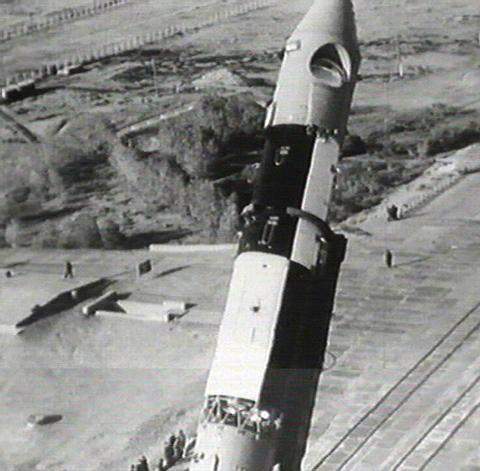
Installing the "Sunrise" on the launch pad. Through the truss between the second and third steps, 4 combustion chambers of the RD-0108 “I” block are visible. Chess coloring of the third stage most likely means that the photo from one of the test launches.
"Voskhod" was taking out a new modification of the R-7 rocket, which had already become the main "workhorse" of Soviet cosmonautics. The Voskhod launch vehicle had a more powerful third stage - the “I” unit, which increased its carrying capacity to ~ 6 tons. And the weight of the "Voskhod" grew slightly, to 5.3-5.6 tons, which meant no weight problems for the ship.

For launching into Gemini orbit, a modification of the Titan-II ICBM was used. Changes consisted in increasing the reliability and redundancy of some nodes. The load capacity of 3.5 tons still lagged far behind the Soviet launch vehicles, which greatly limited the ship's developers. And the specificity of the rocket, designed as an ICBM, led to the fact that the launch was almost uncomfortable than landing - in the final stage of the second stage, astronauts experienced an overload of 8.5 "same", which is unique for launching manned spacecraft (usually not more than 4 g )
External structural elements
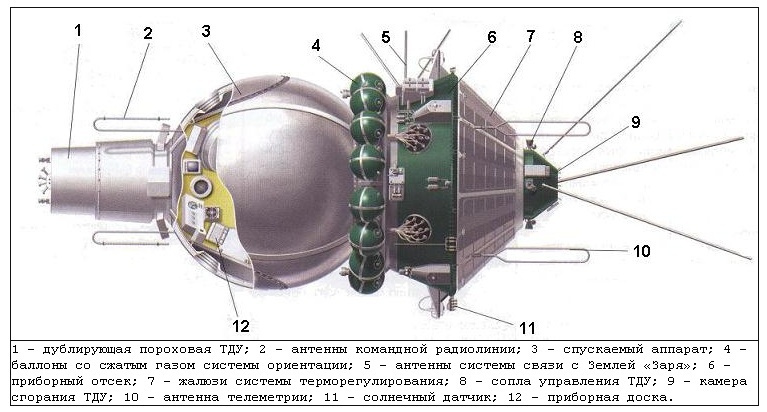

Body shape
Both the USSR and the USA continued to follow their traditions - the Voskhod flew under the fairing and had completely non-aerodynamic forms similar to the Vostok. Gemini was developed by the same firm (McDonnell Aircraft) as Mercury, and both ships were very similar to each other.
Division into compartments

The ship "Voskhod" repeated the scheme of the "East". The spherical lander and the conical aggregate compartment were separated after braking. The already unnecessary aggregate compartment burned in the atmosphere, and the descent vehicle passed through dense layers of the atmosphere and went to land.
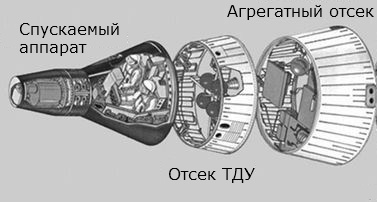
In the ship "Mercury" brake motors were the only part to be dropped. When developing "Gemini", the brake motors were developed into a full compartment, and behind it was placed the aggregate compartment. When returning to Earth, the aggregate compartment was first discharged. Then the brake motors worked. After braking, the unnecessary compartment of the TDU was also dropped. The scheme looks somewhat awkward, but it has the convenience that without the aggregate compartment you need to slow down the smaller mass of the remaining ship, which saves the weight of the brake engines.
Heat protection

The descent vehicle "Voskhod-2". The airlock was added for clarity, in reality it was dropped before braking.
"Voskhod" repeated the idea of "Vostok" with a spherical descent vehicle, automatically occupying the desired position as "Vanka-vstanka" and the same thermal protection. At the same time, certain issues were caused by mounting the airlock, which theoretically could cause the machine to spin. To test the descent safety, a ring similar to the fixation of a lock chamber was installed on one of the Zenit satellite reconnaissance aircraft with the same descent vehicle. The satellite returned successfully, the ring did not prevent the passage of dense layers of the atmosphere or the operation of the parachute.

Gemini used the heat shield already familiar to the United States. Pay attention to the unevenness of his burning - this clearly indicates that the ship made a controlled descent. The center of mass was not on the axis of the ship, so when descending there was a small lifting force:

The lifting force could be used to control the landing process and sit more accurately than in the case of uncontrolled descent.
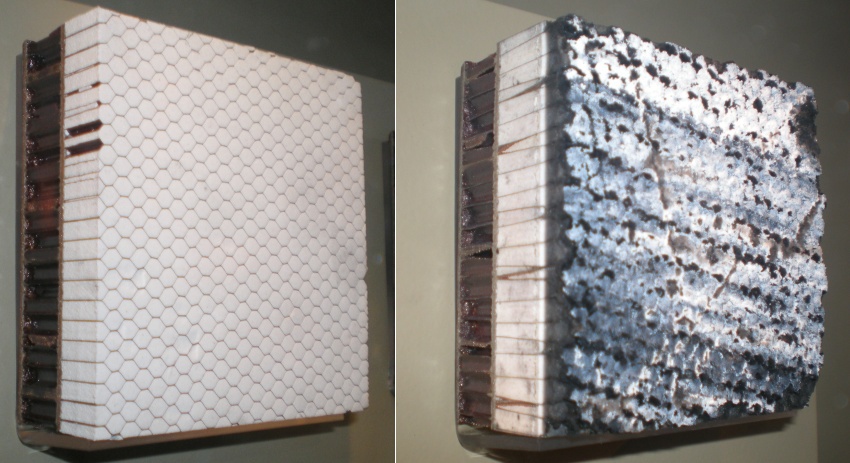
Heat protection material "Gemini" before and after landing
Brake system

At Voskhod, the brake system consisted of a main brake fluid engine and a spare solid fuel one. From a security point of view, this was better than a non-duplicated engine in the "East".

On the "Gemini" in the TDU compartment there were four solid fuel brake engines (a more powerful modification of the engines for the "Mercury"). Four identical engines increased the reliability of braking (the failure of one did not mean a complete failure of braking), but just in case, during the first manned launch of Gemini-3, the height was chosen such that in case of a TDU failure, the ship braked about the atmosphere quickly enough.
Landing system
On the "Voskhod" they refused to eject cosmonauts during landing. First of all, there was no room for a catapult in the new cabin for 2-3 people. Secondly, the idea of the ejection did not seem to be necessary against the background of the experience of the Vostok. The landing system consisted of two main parachutes, a soft landing engine and an earth sensor:
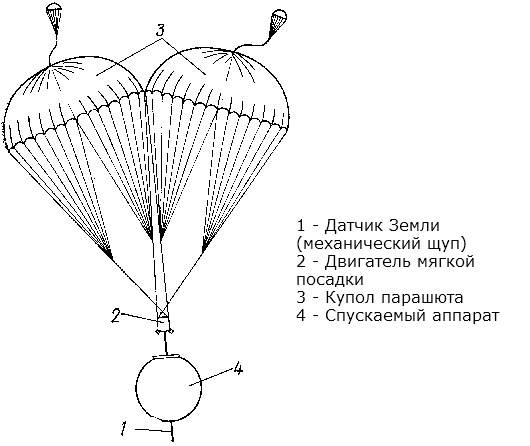
There was no reserve parachute on the ship. Security was somewhat enhanced by the use of a two-dome system (the first and last time in the space program of the USSR). The failure of one dome threatened serious injuries but was not fatal.
In general, despite the lack of a reserve parachute, the landing system was more progressive than that of the Vostok ship. The combination of a parachute and a soft landing engine provided a comfortable enough fit without having to eject from a working ship.
At Gemini, a guided landing was initially proposed on the Rogallo folding wing (by the way, modern hang-gliders grew out of this idea):
But the wing was developed slowly, and at some point NASA decided to return to the already tested parachutes and landing on the water. As a result, a single-dome main parachute was installed on the ship. If it was revealed successfully, the astronauts changed the suspension mode to two-point, and the ship would land in the water diagonally. There was no reserve parachute - in case of failure of the main parachute, the astronauts had to eject.

In the landing system, they abandoned the cumbersome and ineffective shock-absorbing bag “Mercury”, replacing it with an oblique entry of the device into the water. This idea turned out to be excellent, it was used on the Apollo and will be used on the projected ships that will be cast (for example, Orion).
Emergency rescue system
In the "East" rescue system was absent. Up to 27 seconds crew rescue was impossible. In the event of an accident, after 27 seconds the ship was separated from the emergency rocket and used a standard landing system. Fortunately, there were no accidents during the program.
On Gemini, ejection seats were used. Since the launch vehicle used the UDMH / AT fuel pair, according to the calculations of the engineers, it had to explode more slowly, and the explosion should have been smaller than the oxygen-kerosene rocket explosion. Therefore, according to engineers, ejection seats would be enough. The ejection seats weighed less than a full-fledged rescue system and could work as an emergency rescue device during landing.
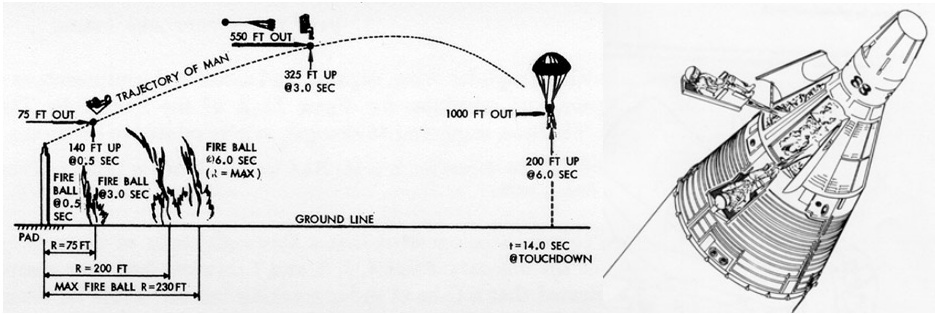
The ejection seats “Gemini” had the most powerful engines among aviation analogues. At the first attempt to launch “Gemini-VIA”, which failed due to a cable falling out of the socket, it was necessary to eject according to the instructions. But the astronauts did not do this, not least because of the test case: because of the small error of the timers of the elements of the rescue system, the chair with the dummy was knocked out by not having time to open the hatch. The astronauts feared for their health during the ejection and would only be able to eject only as a last resort, maybe even later than was necessary.
From the point of view of construction, the emergency rescue system is better than ejection seats, therefore, in a sense, this was a step backward compared to the “Mercury”. Fortunately, there were no accidents and “combat” bailouts during the program.
Orbital maneuvering and orientation engines
Voskhod used compressed gas orientation engines similar to Vostok and could not perform orbital maneuvers.
"Gemini" had two motor systems:
- The Orbital Orientation and Maneuvering System (OAMS - Orbit Attitude and Maneuvering System), which was used during normal flight and allowed to orient the ship and perform maneuvers to change the orbit.
- The orientation system (RCS - Reaction Control System), which was regularly used during the landing and could only turn the ship without changing its orbit.
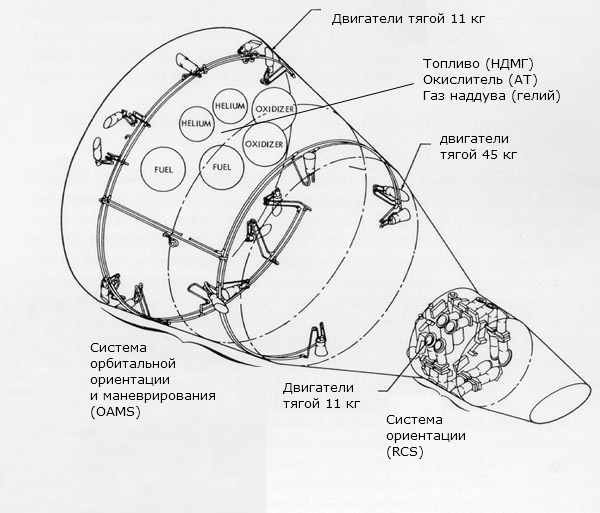
Duplication of motor systems once saved the lives of astronauts. Immediately after the docking of “Gemini-8” (crew of Neil Armstrong, David Scott) with the target of “Agen”, one of the OAMS engines uncontrolledly turned on and began to unwind the ship. Increased rotation threatened with loss of consciousness and death from overload, but Armstrong managed to turn off the OAMS and stop the rotation with RCS engines.
The fuel used was a pair of UDMH / AT. High-boiling fuel with a good specific impulse was much better than hydrogen peroxide or compressed gas, and in Gemini there were also quite large volumes of fuel.
In general, the Gemini motor system proved to be extremely successful both in terms of ideas and execution.
Thermoregulation system
Voskhod used a thermal control system with blinds similar to Vostok. The system was simple, reliable and did not cause any complaints during operation.
Gemini used a liquid thermoregulation system. The coolant took heat from the crew and instruments in the cabin and transferred it to the adapter surface (aggregate module and TDU module). The entire surface of the adapter (white) was a heat emitter. The idea of such a system was very progressive (better than a water vaporizer on the “Mercury”), but there were certain problems with it. Even in the middle of the program (for example, on the “Gemini-7” mission), she chipped off the tricks: the temperature in space suits sometimes dropped to + 4 ° , then it rose to an uncomfortable level.
VCD support systems
Since for both types of ships, the task of extravehicular activity was envisaged, it was necessary to develop appropriate systems to enable the astronaut / cosmonaut to leave the ship and return.
On the "Sunrises" was installed inflatable airlock. When folded, it occupied a minimum of space, and after opening it allowed to leave the ship without dumping the atmosphere in it.
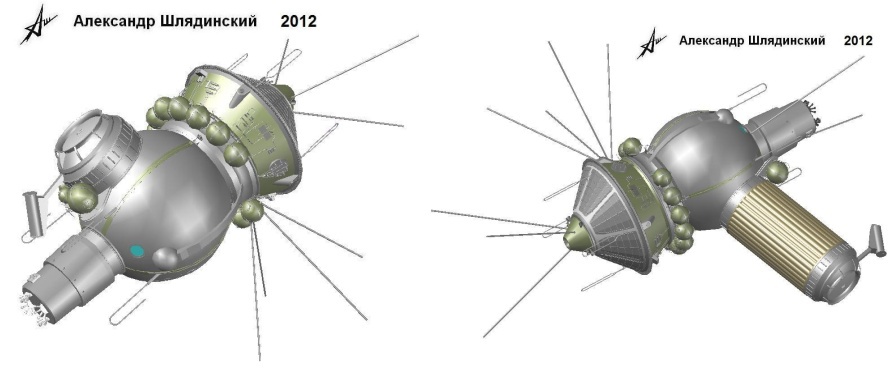
On the left - the airlock folded, on the right - in the open.
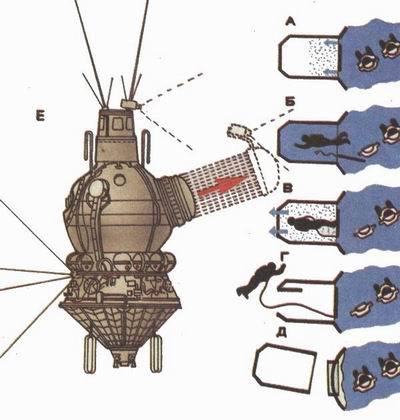
The scheme of the airlock.
At “Gemini”, the cabin was completely sealed, and a regular landing hatch was used for the EVA. During the first spacewalk, it turned out that the developers had forgotten about cold welding of metals in a vacuum - there were problems with the hatch opening.
If we compare these two approaches to the implementation of the task of extravehicular activity, then they both have their pros and cons. A special gateway is beneficial for large ship volumes and high pressure atmosphere. In this case, the loss of depressurization is less. It is also beneficial in that the operation mode of the instruments and other cabin contents is not disturbed. There is no need to design shipboard equipment operating in vacuum. VKD with depressurization of the ship is beneficial for small ships with an atmosphere with low pressure. Both versions were successfully used in the future - the Apollo VCD was depressurizing the ship, and now there are special compartments with gateways on the ISS - the entire ISS cannot be depressurized.
Docking system
Sunrise did not have docking devices.
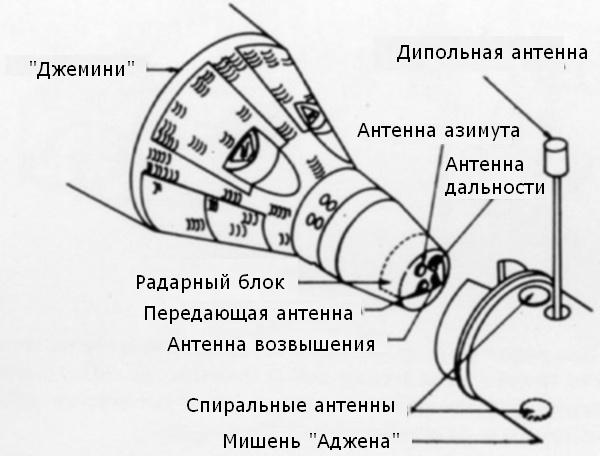
Gemini's nose was used to position the antennas and the docking radar. The nose was also used for docking - the Agen target had a corresponding notch with docking locks, electrical connectors, etc. at the end.
Internal design elements
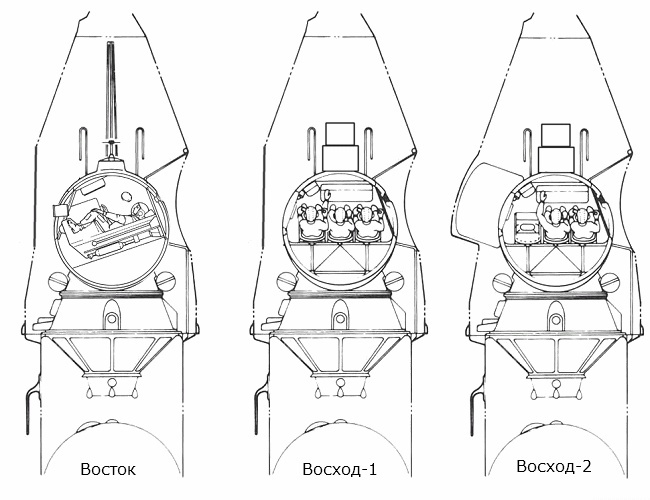

Toolbar
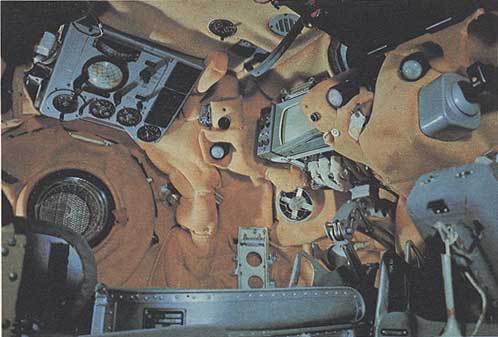
Voskhod recognizes the development of the East toolbar. The main disadvantage is that, despite the rotation of the crew seats (they are in the foreground below, the right side of the seat is visible), the controls remain the same as in the "East", which caused inconvenience in manual control. Portholes are small, but located on different sides.
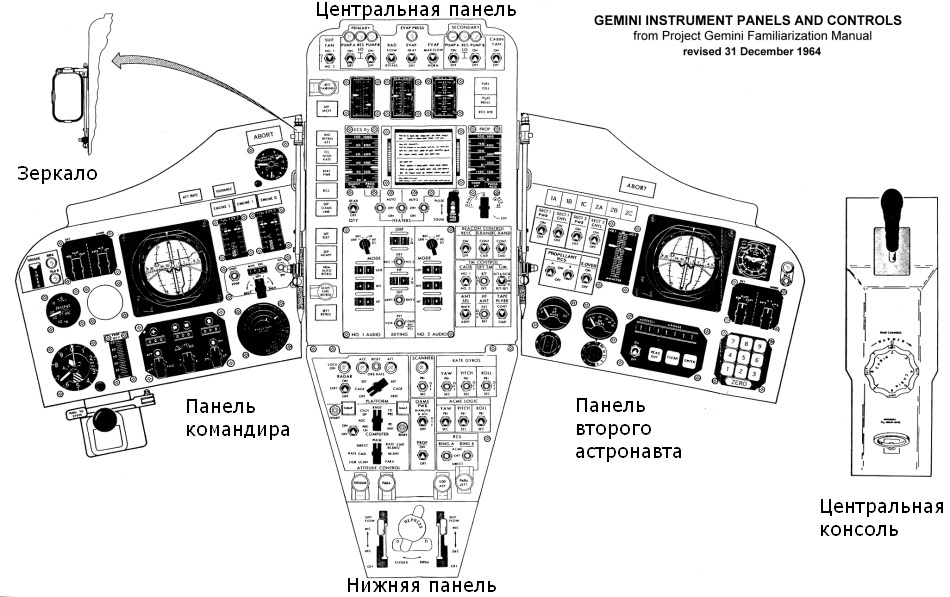
The control panel "Gemini" develops an aviation approach with a variety of instruments. The portholes are located in an airplane, which provides an excellent view ahead. Side windows were not.
Separately, it is worth noting the appearance of the onboard computer. The system could not pilot the ship on its own (as the Apollo on-board computers later did), but it seriously helped the astronauts during docking and landing.
Life supporting system
At "Voskhod-1" they flew without space suits due to lack of space. On the "Voskhod-2" spacesuits were in connection with the need for a spacewalk. On the Voskhod ships, the atmosphere was maintained close to that of the earth.
At Gemini, the flight was carried out in spacesuits, and the atmosphere was similar to Mercury, pure oxygen with reduced pressure.
In terms of convenience, the Gemini were very uncomfortable ships. The astronauts had very little space, it was not possible to stand up, stretch out to their full height, to warm up. The situation was complicated by smells from unwashed bodies (it was not possible to maintain cleanliness of the body, there were no changeable clothes) and use of the toilet. It was especially hard for astronauts on long missions - 8 days of “Gemini-5” and two weeks of “Gemini-7”. The crew of “Gemini-5” called its mission “eight days in the garbage bin”, and the astronauts “Gemini-7”, recalling this mission, say that the last days were especially disgusting, and also blamed each other (now, after so many years , jokingly) in using the toilet too often.
Electrical system
Sunrise used batteries for power. Despite the shortcomings of the batteries for long missions, the ship with dogs successfully flew off for 22 days, i.e. could well be used for a long flight of people.
"Gemini" used the most suitable for flights lasting 2-3 weeks system - fuel cells. Hydrogen and oxygen, connecting, produced electricity, and the resulting water was consumed by the crew. Fuel cells showed excellent performance (if you do not take into account problems in the first flight) and were later used on the Apollo and Space Shuttle.
Conclusion
Voskhod, being, in fact, hastily refined by the Vostok, despite its technical backlog, allowed to solve important political tasks. The first flight of a crew of three and the first spacewalk was widely covered by media all over the world.
- The crew of several people. For the first time, a crew of three flew into space.
- Extra-ship activities (spacewalk). The first spacewalk in history.
- Long flight for two or three weeks. Passed like a drone with dogs. Manned flight canceled.
- Flight of a fully female crew. Canceled.
- Flight with the creation of artificial gravity. Canceled.
- Flying with biomedical experiments, for example, an operation on an animal. Canceled.
- Spacewalker astronaut with an autonomous means of transportation (without a cable connecting with the ship). Canceled.
The ship "Gemini" can be called a ship, which was designed by engineers, not looking at human weaknesses. Small, cramped, uncomfortable, but equipped with advanced technology and possessing unique capabilities at that time. If it were not for the political aspects with the already determined Apollo program, Gemini could have become an excellent and cheap transport to the orbital station (as part of MOL or another project) and even used for flights to the Moon. As for the tasks that the USA set for itself, they were brilliantly solved:
- The crew of several people. Ten flights of crews of two people in just 20 months.
- The duration of the flight is 8-14 days. One flight for 8 days and one flight for 14 days.
- Extra-ship activities (spacewalk). A great number of spacewalks with a total duration of ~ 10 hours are committed. Initial problems have been overcome, simulators and training systems have been developed. WPC late missions passed easily and without problems.
- Docking The first manual docking in history. Successful accomplishment of two docks with different objectives of Agen for one mission.
- Exact landing on Earth. The first manned vehicle with controlled descent. The landing error was measured in units of kilometers.
- Selection and training of crews of future lunar missions. The astronauts of the second set became the commanders of the Apollo missions and successfully applied the acquired skills.
List of used sources
In addition to Wikipedia used:
Source: https://habr.com/ru/post/234351/
All Articles